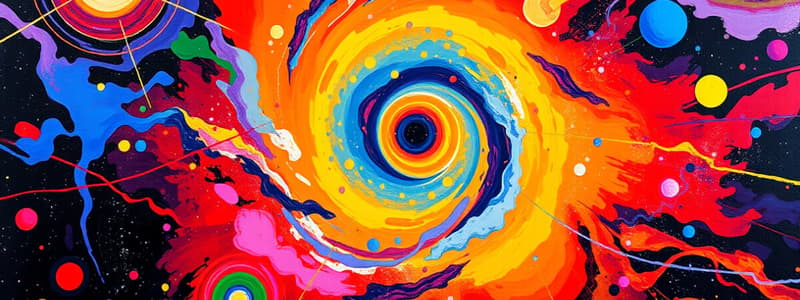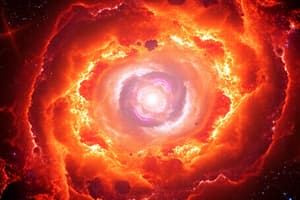Podcast
Questions and Answers
Who was the first proponent of the big bang theory?
Who was the first proponent of the big bang theory?
- Albert Einstein
- Stephen Hawking
- Georges Lemaître (correct)
- Isaac Newton
What did Lemaître use to describe the initial state of the universe?
What did Lemaître use to describe the initial state of the universe?
- The Cosmic Sphere
- The Primordial Bead
- The Cosmic Egg (correct)
- The Universal Atom
What significant evidence did Lemaître theorize would exist if the universe originated from a hot state?
What significant evidence did Lemaître theorize would exist if the universe originated from a hot state?
- Dark matter
- Light from distant galaxies
- Cosmic rays (correct)
- Gravitational waves
What did Lemaître refer to cosmic rays as?
What did Lemaître refer to cosmic rays as?
What did the disintegration of the primeval atom produce, according to Lemaître?
What did the disintegration of the primeval atom produce, according to Lemaître?
What was the main reason Lemaître's theory was initially not accepted by cosmologists?
What was the main reason Lemaître's theory was initially not accepted by cosmologists?
What event does the big bang theory explain?
What event does the big bang theory explain?
What does the term 'singularity' refer to in the context of the big bang theory?
What does the term 'singularity' refer to in the context of the big bang theory?
What happens to matter and antimatter particles when they collide?
What happens to matter and antimatter particles when they collide?
What elements are primarily formed during the nucleosynthesis process?
What elements are primarily formed during the nucleosynthesis process?
Which of the following statements about the rate of expansion and cooling of the universe is correct?
Which of the following statements about the rate of expansion and cooling of the universe is correct?
What did the intense heat from the big bang lead to?
What did the intense heat from the big bang lead to?
What is the significance of the stars formed after nucleosynthesis?
What is the significance of the stars formed after nucleosynthesis?
What is the ultimate result of the formation of galaxies?
What is the ultimate result of the formation of galaxies?
Flashcards are hidden until you start studying
Study Notes
Big Bang Theory Overview
- Cosmological model explaining the universe's origin, beginning its expansion around 13.8 billion years ago.
- Universe started as a "singularity," a highly dense and hot core similar to conditions in a black hole.
- Singularity's nature remains a mystery, yet it continuously expands and cools.
- Rate of expansion nearly matches the cooling rate, influencing the formation of matter and antimatter.
Formation of Matter
- Intense heat from the singularity allowed for the creation of matter and antimatter particles.
- Matter and antimatter collided, annihilating each other in the early universe.
- Nucleosynthesis resulted in the formation of fundamental elements, primarily hydrogen and helium.
Formation of Cosmic Structures
- Hydrogen and helium presence led to the creation of stars and galaxies.
- Stars facilitated the emergence of other cosmic bodies, including planets, comets, and asteroids.
Georges Lemaître's Contribution
- Georges Henri Joseph Edouard Lemaître, a Belgian priest, first proposed the expanding universe theory.
- In 1931, he described the universe's origin as an explosive event involving a "Cosmic Egg" or primeval atom.
- Suggested that energy from the primeval atom explosion triggered the universe's expansion.
Recognition and Empirical Evidence
- Lemaître’s ideas were initially overlooked by many cosmologists due to lack of empirical support at the time.
- He theorized that a hot early universe would leave detectable traces, which he later identified as cosmic rays.
- Described cosmic rays as remnants from the disintegration of the primeval atom, akin to “ashes and smoke” from rapid fireworks.
Cosmic Rays and Stars
- Cosmic rays originated during the early star formation around 10 billion years ago, rather than directly from the primeval atom.
- Lemaître visualized the disintegration of the primeval atom into atomic stars, leading to the production of cosmic rays.
- His work suggested that cosmic rays are glimpses of the primordial fireworks associated with star formation.
Studying That Suits You
Use AI to generate personalized quizzes and flashcards to suit your learning preferences.




